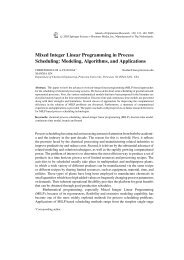Conceptual framework: What do you think is going on?
Conceptual framework: What do you think is going on?
Conceptual framework: What do you think is going on?
Create successful ePaper yourself
Turn your PDF publications into a flip-book with our unique Google optimized e-Paper software.
03-Maxwell.qxd 10/1/2004 3:13 PM Page 58<br />
58 QUALITATIVE RESEARCH DESIGN<br />
research and her prior beliefs had led her to underestimate the l<strong>on</strong>g-term<br />
c<strong>on</strong>sequences of the cancer experience for her family. She learned that<br />
she needed to step back and l<str<strong>on</strong>g>is</str<strong>on</strong>g>ten to participants’ experiences in new<br />
ways. Finally, she found that her own children’s resp<strong>on</strong>ses were sometimes<br />
guarded and predictable, due to the c<strong>on</strong>sequences of what they said<br />
for family relati<strong>on</strong>ships, and tended to minimize negative feelings or<br />
blame. Although the pilot study was valuable, it could not fully answer<br />
the questi<strong>on</strong>s she had (Kaffenberger, 1999).<br />
One important use that pilot studies have in qualitative research <str<strong>on</strong>g>is</str<strong>on</strong>g> to<br />
develop an understanding of the c<strong>on</strong>cepts and theories held by the people <str<strong>on</strong>g>you</str<strong>on</strong>g><br />
are studying—what <str<strong>on</strong>g>is</str<strong>on</strong>g> often called “interpretati<strong>on</strong>.” Th<str<strong>on</strong>g>is</str<strong>on</strong>g> <str<strong>on</strong>g>is</str<strong>on</strong>g> not simply a source<br />
of additi<strong>on</strong>al c<strong>on</strong>cepts for <str<strong>on</strong>g>you</str<strong>on</strong>g>r own theory, <strong>on</strong>es that are drawn from the language<br />
of participants; th<str<strong>on</strong>g>is</str<strong>on</strong>g> <str<strong>on</strong>g>is</str<strong>on</strong>g> a type of c<strong>on</strong>cept that Strauss (1987, pp. 33–34)<br />
called “in-vivo codes.” More important, it provides <str<strong>on</strong>g>you</str<strong>on</strong>g> with an understanding<br />
of the meaning that these phenomena and events have for the people who are<br />
involved in them, and the perspectives that inform their acti<strong>on</strong>s. These meanings<br />
and perspectives are not theoretical abstracti<strong>on</strong>s; they are real, as real as<br />
people’s behavior, though not as directly v<str<strong>on</strong>g>is</str<strong>on</strong>g>ible. People’s ideas, meanings,<br />
and values are essential parts of the situati<strong>on</strong>s and activities <str<strong>on</strong>g>you</str<strong>on</strong>g> study, and<br />
if <str<strong>on</strong>g>you</str<strong>on</strong>g> <str<strong>on</strong>g>do</str<strong>on</strong>g>n’t understand these, <str<strong>on</strong>g>you</str<strong>on</strong>g>r theories about what’s <str<strong>on</strong>g>going</str<strong>on</strong>g> <strong>on</strong> will often<br />
be incomplete or m<str<strong>on</strong>g>is</str<strong>on</strong>g>taken (Maxwell, 2004a; Menzel, 1978). In a qualitative<br />
study, these meanings and perspectives should c<strong>on</strong>stitute a key comp<strong>on</strong>ent of<br />
<str<strong>on</strong>g>you</str<strong>on</strong>g>r theory; as d<str<strong>on</strong>g>is</str<strong>on</strong>g>cussed in Chapter 2, they are <strong>on</strong>e of the things <str<strong>on</strong>g>you</str<strong>on</strong>g>r theory<br />
<str<strong>on</strong>g>is</str<strong>on</strong>g> about, not simply a source of theoretical insights and building blocks for the<br />
latter. In Example 3.2, the norms and values held by the physicians studied by<br />
Freids<strong>on</strong> were a major part of what was <str<strong>on</strong>g>going</str<strong>on</strong>g> <strong>on</strong> in the medical practice, and<br />
are fundamental to h<str<strong>on</strong>g>is</str<strong>on</strong>g> theory. Such meanings and perspectives are also key<br />
comp<strong>on</strong>ents of all of the previous examples of c<strong>on</strong>cept maps (Figures 3.1 to<br />
3.5). Even in Figure 3.5, in which the c<strong>on</strong>cepts are mostly stated in terms of<br />
behavior or c<strong>on</strong>textual influences, “job insecurity” refers to perceived insecurity;<br />
if participants were unaware that their jobs might be eliminated, their<br />
behavior wouldn’t be affected.<br />
THOUGHT EXPERIMENTS<br />
Thought experiments have a l<strong>on</strong>g and respected traditi<strong>on</strong> in the physical<br />
sciences (much of Einstein’s work was based <strong>on</strong> thought experiments) and are
















